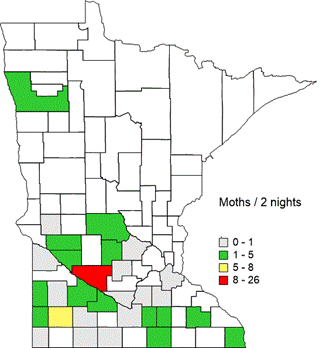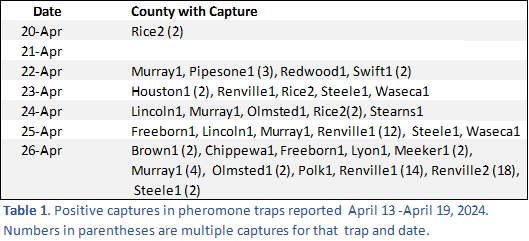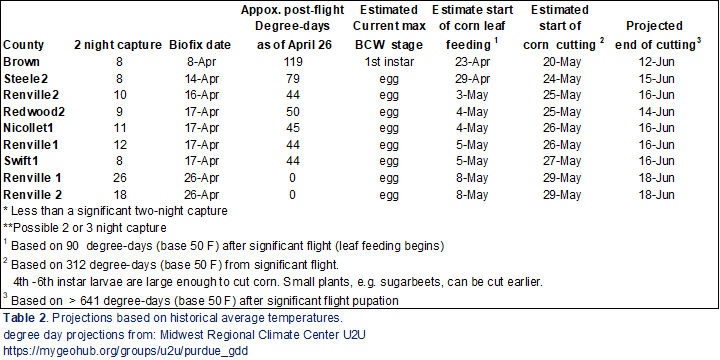2024 University of Minnesota Cooperative Black Cutworm Trapping Network
Report #3 April 20 -26, 2024
For more information: https://z.umn.edu/bcw-reporting
April 15, 2024
Greetings:

The trapping week started out quietly with most traps capturing no or only a few black cutworm moths. Late in the week, strong southerly winds began to bring black cutworm (BCW) moths to Minnesota. These moths moved northward on the same system that brought tornados to Nebraska and later Oklahoma.
Two Renville County traps had very large and significant captures (18 and 26 moths captured over a two-night period) on April 25-26 (Figure 1, Table 1,2). Degree day predictions to help time scouting for 2024 moth captures can be found in Table 2. Reports of additional large captures April 27 - 29 will be reported in the next issue.
BCW moths, wanting to migrate, fly upward from the overwintering areas at dusk. If weather systems cooperate, they are whisked off by surface winds and rising air in advance of thunderstorms into the lower-level jet stream. These winds are strongest at night, moving at 30 to 80 miles per hour, and can occur from about 330–3,000 feet in altitude. The flight is mostly passive with moths carried along until they decide to “drop out”, encounter air too cold for flight, or rain out in thunderstorms.
The time and the location of traps with high moth captures have been very sporadic since April 8. This is typical and reflects packets of migrating moths within the northward moving low-level jet stream and local weather when they arrive in Minnesota. This unpredictability means at-plant prophylactic treatments for black cutworm seldom provide an economic return. Scouting and treatment of economically threatening infestations provide a better return on a pesticide investment. The goal of this project is to provide information to growers and their advisors for predicting when and where to scout for black cutworm.
In some areas of Minnesota corn planting is wrapping up. Those fields worked before moth arrival are at less risk. Small larvae will feed on weeds or corn leaves. Corn stand loss occurs when plants are cut at or below the growing point. BCW larvae need to reach the 4th instar before they are able to cut off corn and seedling soybeans. Small sugarbeets are vulnerable to somewhat smaller larvae. Higher seeding rates and the ability to compensate for reduced stands decrease soybeans’ risk from black cutworm induced yield. However, soybean stand can still be impacted, especially in pockets of the field. Sugar beets are vulnerable.
When you are out assessing emerging stands over the next few weeks pay close attention to small cut weeds and leaf feeding on weeds and corn. Next week, I’ll give some tips on how to make scouting more efficient. In the meantime, you might find the scouting information section of black cutworm on corn useful.
True armyworm (TAW)
Armyworm moth migration detected in pheromone traps continues to be very low. Pheromone traps picked up only another single moth on the 25th in McLeod County. Blacklight traps will be added to the moth detection arsenal in May.
This project is supported, in part, by the farm families of Minnesota and their corn check-off investment.


Until next week,
Bruce Potter
